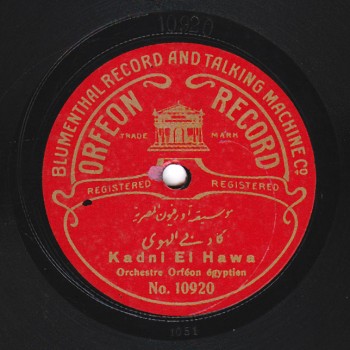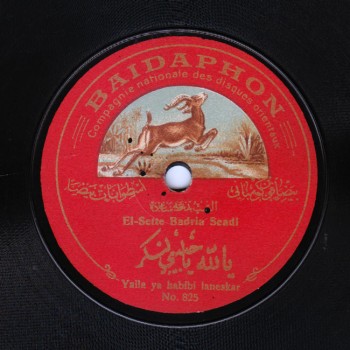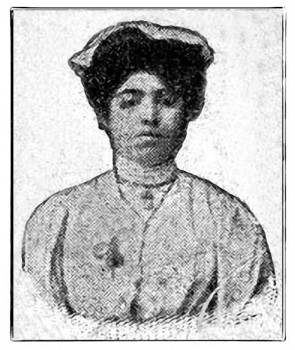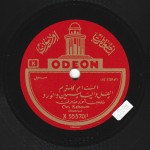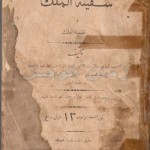The Arab Music Archiving and Research foundation (AMAR), in collaboration with the Sharjah Art Foundation (SAF), presents “Niẓāmunā al-Mūsīqī”.
Many centuries after Al-Urmawī’s notation type was deduced, did Dimitrie Cantemir develop it significantly, i.e. including all the music details? Was he able to transcribe many pieces? Was he able to preserve the musical heritage that existed in his time?
Dimitrie Cantemir developed notation to a point where, for example, he stated the uṣūl of a dawr kabīr –a 28 dawr–, and those of longer rhythms. He transcribed instrumental pieces with the uṣūl and the melody into scores that lead to very little confusion. There is of course some confusion as to the pace. The pulse is indicated in most of his music transcriptions, but a few only indicate for example “uṣūl samā‘ī”, and one wonders whether it is a 6 or a 10-pulse’ rhythm since it can be read as one or the other. We have recordings of Turkish bands who played pieces transcribed by Cantemir either to a 6 pulse’ rhythm or to a 10-pulse rhythm.
I.e. thaqīl or yurūk.
Yes. The melody remains the same because its segmentation works for both. Both recordings are good. Still, he developed to the point of reaching the “petite note”: he developed a lot and started to transcribe vocal ranges that were higher than those transcribed by Al-Shīrāzī.
The name Dimitrie Cantamir is clearly neither Turkish, nor Arab or Persian.
He was among the Romanian princes sent to the Ottoman court as hostages to guarantee loyalty to the kings. So ‘Alī Ufqī Bēh and Dimitrie Cantemir were among the prisoners of the Turks, not war prisoners but hostages the Sultan took as children and raised until they grew older and remained loyal to them after the father died. Meanwhile, they remained hostages so their father would not turn against the Ottoman Sultan. Bulgarian ‘Alī Ufqī and Romanian Dimitrie Cantemir were both among those. ‘Alī Ufqī died in the 50’s of the 17th century, maybe in 1653, and Dimitrie Cantemir probably died in 1702.
‘Alī Ufqī is a Muslim name.
His name was surely not ‘Alī Ufqī. He took this name later.
‘Alī Ufqī was not a musician… he only played music.
He was an Ottoman ambassador, spoke many languages, and worked as court translator, which earned him the title of Bēh, unlike Cantemir.
‘Alī Ufqī Bēh was the first who entered contemporary music notation into music notation in the orient in general: he transcribed music on a 5-line’ staff and formulated new terms for the accidentals particular to Ottoman court music then.
Alī Ufqī Bēh did not follow Ṣafiyiddīn al-Urmawī’s path: he worked with a 5-line staff that he seems to have learned before being taken prisoner or hostage by the Ottoman Sultan. So he used it to transcribe music pieces.
It seems that he did it exclusively for personal use as there are strange annotations on his scores indicating for example whether he wanted to go one octave up or one dīwān down. He transcribed them as he wanted to perform them.
The margins bear indications on the way he liked to perform these pieces.
So this is not a book… ‘Alī Ufqī Bēh did not write a book. These are only drafts put together by someone –some of which are distributed over museums in Europe– of songs and instrumental pieces he liked to play or maybe played for the Sultan… But they are not gathered into a book. There is no indication that these transcriptions were of a theoretical nature, still they were transcribed with the correct western score including the uṣūl of melody, i.e. the maqām of course.
Even though ‘Alī Ufqī came before Dimitrie Cantemir.
Indeed. Yet he used the western score, while Dimitrie Cantemir arrived at a younger age and learned about the older music transcriptions, and consequently developed the alphabetical notation of both the 13th and the 14th centuries.
Was the musical production transcribed by Ufqī and Cantemir exclusively in Turkish?
No. ‘Alī Ufqī transcribed Persian and Arabic texts.
Great.
Cantemir mostly transcribed instrumental pieces, except for a very few songs, unlike ‘Alī Ufqī who followed the European musical system but transcribed from right to left: clef and time signature on the right, and the whole score is from right to left with the lyrics above. ‘Alī Ufqī invented the right-to-left notation system, probably because he wrote the lyrics in Arabic, and thus wanted to read them from right to left along with the notes. So he produced a right-to-left western score.
Which piece will you play for us out of ‘Alī Ufqī’s or Cantemir’s book? Of course, Cantemir’s mostly includes instrumental music while ‘Alī Ufqī includes mostly singing.
We could listen to “Ṣalāt al-‘īd” (the Eid prayer) transcribed by ‘Alī Ufqī, in the voice of a Turkish performer as it was probably recited during the latter’s day. It is probably still in the oral tradition today.
So we could listen to this prayer “Allāhumma ṣallī ‘ala Sayyidinā Muḥammadin wa-‘ala ālihi wa-ṣaḥbihi”…etc.
(♩)
Now, let us listen to the dārij ḥijāz attributed to Madanī Muṣṭafa ‘Iṭrī. The Sulaymani translations stated that Madanī Muṣṭafa ‘Uṭrī lived in the late 16th century and served at the court of Sulaymān al-Qānūnī and after him, and that he came from Mecca to the Topkapi Palace.
The following are attributed to him: “Al-na‘t al-sharīf”, and some songs whose Arabic texts are written in ‘Alī Ufqī Bēh’s book.
The book of ‘Alī Ufqī and Dimitrie Cantemir includes this samā‘ī dārij ḥijāz that includes more than one khāna. We only have two khāna performed by Sāmī al-Shawwā, Zakī al-Qānūnjī, Petro al-‘Awwād, ‘Alī al-Darwīsh and recorded by Baidaphon in 1924. They had surely not read ‘Alī Ufqī Bēh’s book, but the piece was transmitted orally until it reached them. Dimitrie Cantemir transcribed it to the same melody with the addition of other khāna.
(♩)
How was Arab music notation done before the 19th century after Cantemir?
I think that music notation in the 15th and the 16th centuries was not done in order to document the music as much as it was done for teaching purposes, and that music notation was not the essential method to transmit the musical heritage across generations, because it was mostly oral transmission.
Yes.
Up to recently…
Villoteau –music author, theorist and teacher who lived at the end of the 18th century and in the 19th century – assigned to write the musical section in book “Waṣf Maṣr” during Napoleon’s campaign, came to Egypt with the campaign and transcribed many melodies. He said: Thanks to our Greek friends, we were able to learn about Dimitrie Cantemir’s transcriptions. He may have also learned about ‘Alī Ufqī… Anyhow, Cantemir himself wrote that he learned about him. Villoteau wrote that he transcribed what the musicians were performing and then sang what he had written, and that most ran away, thinking it was witchcraft, and that these writings were hieroglyphs…
These are the narrator’s words, not mine.
So, neither alphabetical notation nor the 5-line staff symbols notation were well-know. He transcribed songs sang by the Egyptians on the street, including “Sārī ‘askar dāyir yiskar”…etc. I do not know why he transcribed this song that attacked the campaign and Napoleon Bonaparte.
It was a contemporary song at the time… a new song…
Indeed.
He also transcribed melodies said to be old songs and muwashshaḥ, such as “Yā lābisīn al-shīshiklī”. In the beginning of the 20th century, many recorded this melody (that is very easy to read), notably Badriyya Sa‘āda in Beirut with Baidaphon, though she sang it with other lyrics “Yallā bīnā yā ḥibbī niskar”.
Villoteau wrote the maqām according to what the musicians told him at the time, as well as the rhythmic beat, adding accidentals for the scales that sounded foreign to his ear. If we ignore these symbols, the data he gave us such as the rhythm and the melody allow one to play the melody 100% right (not in any other proportion). It is very easy to read. He even wrote the same melody twice: one score with a simple notation, and a score including the embellishments.
(♩)
You talked about the experts of the French campaign as well as about the western notation that was contemporary then and that resembles today’s notation.
He only added some symbols for the scales that sounded foreign to his ear.
Symbols like the letter “X”…
One does not need them if one knows the pattern of the maqām… it is very easy to deduce.
Did the Arabs try to invent a music notation system at the same time or later?
Both “Safīnat al-Qubaysī” written before the French campaign, i.e. around 1789 and “Safīnat Muḥammad Shahāb” written around 1836 dealt similarly through musical theory and the writing of maqām, with the rhythms they transcribed with dum and tak, and with the muwashshaḥ they transcribed with maqām and beat. For example: muwashshaḥ “Ḥayyar el-afkār”, 4-pulse’ kardān, placed in the rāst waṣla. This was the most detailed music notation then.
Mīkhā’īl Mashāqa wrote the melodies of 95 maqām: simple melodies transcribed like those in “Al-Shajar Dhāt al-Akmām”, and those by Al-Lādhiqī, Al-Ṣafadī, and Al-Ṣīḍāwī.
Were the notes –rāst dūkāh, sīkāh for example– used to explain the melody itself?
Neither from “Al-Shajar Dhāt al-Akmām” up until Mīkhā’īl Mashāqa, nor in any “Safīna”.
When did the notation of contemporary –19th century– Arab music start?
Contemporary Arab Music was transcribed starting when Muḥammad ‘Alī established the Military Academy. We know that scores were written following the western type in the 19th century, but exclusively for military purposes, mostly marches, and tunes like “Tūbī yā ḥilwa” or “El-‘afū yā sīdī el-milāḥ” that are reflected in 20th century recordings of the Egyptian Infantry band or the music of the Police Academy. But, honestly, these scores distort the tunes more than they transmit them, because they were transcribed by persons who had studied in France, and who only knew the “Majeur” and the “Mineur” in music notation. Moreover, the segmentation of the melodies was difficult.
Let us listen to “Kādnī el-hawā” played by the brass band.
(♩)
Now let us hear how the madhhab should sound.
(♩)
It sounds like a totally different tune.
Yes.
What about the music notation of Muḥammad Dhākir who also had something to do with the military?
Indeed. He graduated from the Military Academy but also knew the uṣūl of Arab music and Turkish music then. He studied the western score and the sāzindā books that included some Turkish transcriptions, such as Muḥammad Hāshim’s. In his book, he referred to these books for the benefit of those who wanted to learn the notes. He wrote a way to teach music transcription, but never transcribed anything himself.
Yes.
He wrote the sequence of maqām, but there isn’t any bashraf transcribed in his hand. I honestly doubt his ability to read and write, because we have nothing transcribed in his hand.
The one who did know is Kāmil al-Khula‘ī who wrote in his hand transcriptions of muwashshaḥ with high precision, unlike the transcriptions of the military brass band. His music notation included the details, the correct accidentals, iss as well as melodic and rhythmic segmentation. He was knowledgeable about the tools of the western notation adopted since the 19th century.
It is said that ‘Abduh al-Ḥāmūlī went to the Ottoman Sultan and promised to transcribe for him his dawr following the western notation in order to allow Turkish musicians to sing them for the Sultan.
Yes.
During the same period, brothers Tawfīq, Iskandar, and Salīm Shāmlī or Shāmī who were from Damascus in Syria and worked in Istanbul authored many books on the sāzindā including mostly precisely transcribed musical pieces. They also presented sharqī oriental Ottoman songs and some dawr –maybe one dawr per book.
True.
So, this was done by Arabs in Istanbul…
The question is:
In the music notation used by the Turks and the Arabs at that time, the first line was the Si or B, while in international notation today the first line is the Mi or E. This difference implies the existence of different international music notations, even if the form is the same. Do you have any information about this?
All I can say is that ‘Alī Ufqī Bēh’s yakāh is the Re.
But why? Is it because the first line is the Mi, so he placed the yakāh under the first line? I am not sure this logic is correct.
Why is the yakāh the equivalent of the Re? The simplest explanation is that the first line being the Mi, then the yakāh would be the Re. Then, one can choose to play it to the manṣūr, shāh, kīz, yildiz, sīpürde, or to the bulāhenk…
Yes.
The proof that the virtual did not exist then is that book “Safīnat al-Mulk”, for example, says: “Speaking of which, we mention the scales” and he mentioned 4 scales: the safārjā, the kūjāk –that are probably the sīpürde and the kīz, but that he understood as safārjā and kūjāk. The scales are: the dāwūd, the shāh, the manṣūr, the kīz, the yildiz, the sīpürde, and the bulāhenk. These are apparently the scales used, i.e. the nāy’s different lengths. Whatever the scale played, the yakāh was the Re. One was free to translate at whim.
So the song or the piece can be played to more than one scale, based on the appellation of the musical scale or note.
Exactly.
The dārij is maybe the bulāhenk.
Today, in Turkey, the most used dārij is the bulāhenk. By the recordings do not show that this was the case in the past.
Today, Arabs call it the Turkish notation.
Turkish or not… Well, the Congress of Arab Music followed the same notation type, as well as Sāmī Al-Shawwā in his first book. He only went back to 4 later. I think it is a question of choice.
Even the music notation in Jamīl Bashīr’s book “Al-‘ūd wa-Ṭarīqat Tadwīnih” (The ‘ūd and the way to transcribe it) in 1960 –i.e. quite recently– was the same.
Yes. But the yakāh he played on his ‘ūd was a Re, i.e. he played to the manṣūr. So, if the yakāh is the Re, then the rāst is the Sol, implying that it is the manṣūr according to the Turkish nomenclature.
In the past, there was the western notation, and the oriental notation. The oriental notation considered the first line as the “Si” for us today, and today’s western notation that considers the first line as the “Mi”.
As a kid, I heard a man saying that he could read the oriental score as well as the western score. I thought he was talking nonsense.
The “Do” clef and the “Sol” clef.
I only understood later that it was not. I just knew nothing about the matter then and thought he was exaggerating.
Today Arab Music Institutes and educated musicians use the same system. This notation came from a very different culture, which is the western culture and was made for westerners. Today, we use it with some alteration around the use of quartertones for example and the use of a specific symbol to illustrate them, such as the quarter sharp and the quarter flat. Is this enough to illustrate Arab music and to transcribe it? Or is it insufficient?
Even the Turkish notation that includes more accidentals than ours is insufficient.
When the 19th century and 20th century experienced musicians transcribed music, like Sāmī Al-Shawwā, they pointed out that the notation was not precise, and that one had to listen and learn from a teacher. It was just a first documentation notation of a work. Even the maqām’s rising and falling symbols are different, and they are performed differently. The score shows it. There is also the tuned meter of the contemporary piano where 100 cents equal a semitone, and thus 50 cents equal a quartertone. These fixed dimensions of one maqām, rising and falling in a similar way … all this tires me…
As much as music notation can be precise, and as many accidentals as can be invented, it will never be sufficient. Our music is not geometric, not a harmonic (vertical) structure and thus the hearing plays a very important part. And the performance is part of the creation process. The most precise performer is not necessarily the best, as the best one is the best interpreter. So it does not depend on one’s reading of the score and how one executes it, it depends on one’s ability to interpret the musical text, which determines one’s talent as a musician. The creation process and the performance process are not separate. The performer is part of the creation process. Unlike western music –the romantic western classical music starting the 19th century, not western music in general– where the more a performer executes the author’s will precisely, the better he is…
While during the Baroque Period, the Basso Continuo was improvised… Mozart’s texts are interpreted…
So, whether in the east or the west, music notation has never proved its ability to transform sound art into readable art.
Are the names of the notes sīkāh, nawā, ḥusaynī”…etc. very old? Did they change? Were they developed?
In the 14th century, the appellations were: yakāh, dūkāh, sīkāh, jahārkāh, banjkā, shīshkā, haftkā, in the qarār and in the jawāb.
It is said that the term yakāh was later changed to rāst to indicate that it was mustaqīm, i.e. that the sulṭānī meter is mustaqīm. Rāst is a Persian word that means mustaqīm (straight/rectilinear). The banjkā was changed to nawā…etc. These changes were made across the centuries. The yakāh became the first note, and the dūkāh was the 5 dimensions far from the yakāh… according to Al-Khula‘ī. Knowing that these were the yakāh, dūkāh, sīkāh, jahārkāh, banjkā, shīshkā, haftkā, i.e. the first, second, third, fourth, fifth, sixth, and seventh notes, and thus that they form an octave and that this is the sulṭānī meter will help one easily understand how this meter came about.
Since most appellations are Persian, does this imply that the origin of our music is Persian? Can you explain this?
Ibn Sīnā wrote about the rāst mustaqīm… Was it called mustaqīm before it became rāst? Considering that the court that attracted the artists then was the Turkish court and that most musicians were Persian during Sulaymān al-Qānūnī’s era, and a little before him and after him… He had brought over Al-Ṣafawī’s musicians who took Persian names… Did it happen before that? It is a shared musical tradition.
Turkish researcher and famous ‘ūd player Cinuçen Tanrıkorur said about the maqām created recently in the 20th century, that their composer gave them a Persian name even if he was a Turk or an Ottoman, in order to give a deeper and more ancient image of the maqām, for it to comply with the known musical system.
Maybe like the Italian language for Opera and Bel Canto. They may have considered that Persian was the language of music or the language of the court…
Or because, as I mentioned, the Persians were interested in theoretical music and its notation.
Exactly like the issue of books’ titles. Why were they in Arabic? Why was the title of Cantemir’s book or even Muḥammad Hāshim’s and most Turkish books written in the 16th, 17th and 18th centuries in Arabic? The title was in Arabic while there was not one Arabic word in the book? How did they conduct the linguistic taqsīma? Only an anthropologist can explain this. I can’t.
I think we should end this episode with a work played in an interpreted version, then with a performance of the same work that follows exactly the musical text without any kind of interpretation. What do you think?
Ok. Let us listen to two samples of the same work in two different versions.
(♩)
We have reached the end of today’s episode.
My guest Mr. Mustafa Said and myself Ahmad al-Salihi thank you for listening.
“Niẓāmunā al-Mūsīqī” is brought to you by Mustafa Said.
- 221 – Zakariyya Ahmed – 12 (1/9/2022)
- 220 – Zakariyya Ahmed – 11 (1/9/2022)
- 219 – Zakariyya Ahmed – 10 (11/25/2021)
- 218 – Zakariyya Ahmed – 9 (10/26/2021)
- 217 – Zakariyya Ahmed – 8 (9/24/2021)
- 216 – Zakariyya Ahmed – 7 (9/4/2021)
- 215 – Zakariyya Ahmed – 6 (8/28/2021)
- 214 – Zakariyya Ahmed – 5 (8/6/2021)
- 213 – Zakariyya Ahmed – 4 (6/26/2021)
- 212 – Zakariyya Ahmed – 3 (5/27/2021)
- 211 – Zakariyya Ahmed – 2 (5/1/2021)
- 210 – Zakariyya Ahmed – 1 (4/28/2021)
- 209 – W-al-Lāhi lā astaṭī‘u ṣaddak 2 (4/6/2017)
- 208 – W-al-Lāhi lā astaṭī‘u ṣaddak 1 (3/30/2017)
- 207 – Bashraf qarah baṭāq 7 (3/23/2017)

